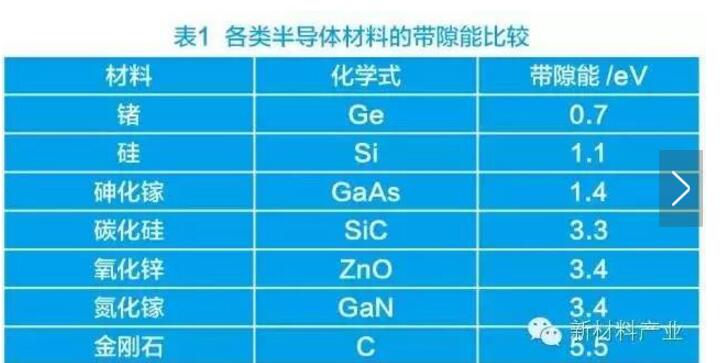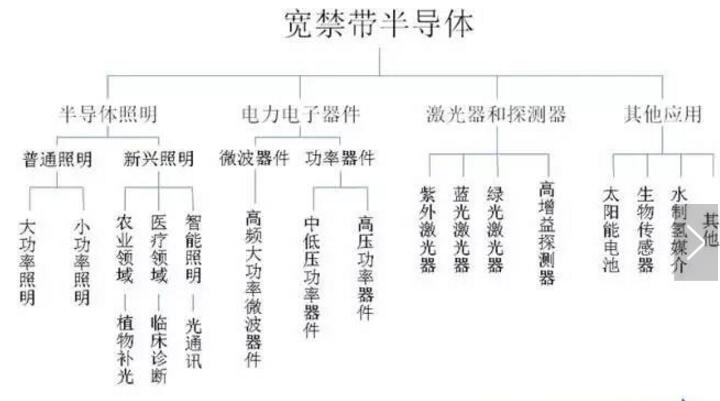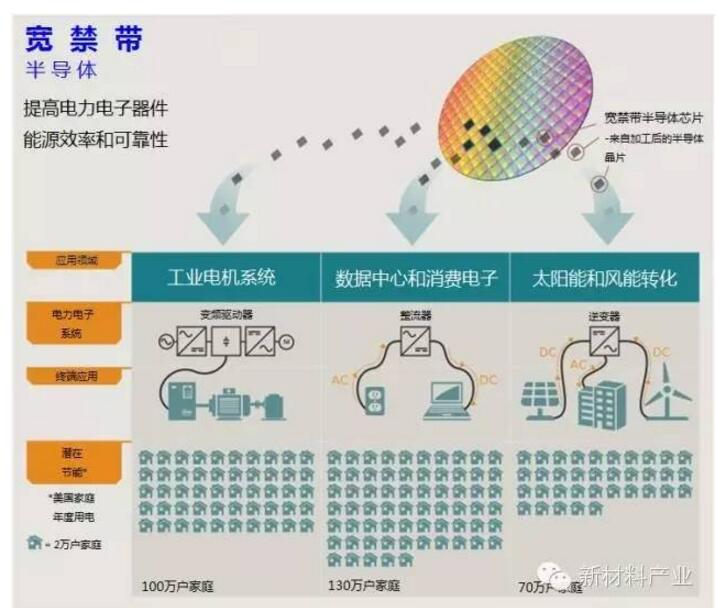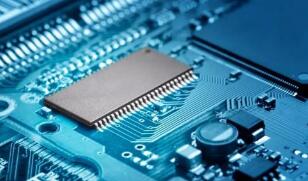The third generation semiconductor refers to a wide bandgap semiconductor material represented by gallium nitride (GaN), silicon carbide (SiC), diamond, and zinc oxide (ZnO). The bandgap energy of various semiconductor materials is shown in Table 1. The 3rd generation semiconductors have a large bandgap, a high breakdown field, a high thermal conductivity, and an electron-saturated drift speed compared to the conventional first- and second-generation semiconductor materials silicon (Si) and gallium arsenide (GaAs). Its unique properties, such as its high height and low dielectric constant, make it show great potential in optoelectronic devices, power electronics, RF microwave devices, lasers, and detectors. It is a hot topic in semiconductor research in countries all over the world. At present, the third generation of semiconductor materials is causing a revolution in clean energy and a new generation of electronic information technology, whether it is lighting, household appliances, consumer electronics, new energy vehicles, smart grids, or military products, all of which are high-performance semiconductors. There is a great demand for materials. According to the development of the third-generation semiconductors, its main applications are semiconductor lighting, power electronics, lasers, and detectors, as well as four other fields, each of which has a different degree of maturity (see Figure 1). In the field of power electronics, the application of wide bandgap semiconductors has just started and the market size is only a few hundred million US dollars. Its application is mainly concentrated in the field of sophisticated military equipment and is gradually expanding into the civilian field. For microwave devices, GaN high-frequency high-power microwave devices have begun to be used in military radars, smart weapons, and communication systems. In the future, GaN microwave devices are expected to be used in civilian applications such as 4G to 5G mobile communication base stations. For power devices, the application areas of GaN and SiC are different. The main applications of Si-based GaN devices are mid- and low-voltage (200 to 1 200V) switching power supplies such as notebooks, high-performance servers, and base stations; while SiC-based GaN is concentrated in high-voltage applications (>1 200V), such as solar power, and new Energy vehicles, high-speed rail transport, smart grid inverters and other devices. In the 20th century, silicon-based semiconductor power electronic devices were widely used in computers, communications, and energy industries, bringing people a variety of powerful electronic devices that profoundly changed the lives of everyone in the past decades. China has always promoted scientific progress and development. As silicon-based power electronic devices gradually approach their theoretical limit, power electronic devices fabricated using wide bandgap semiconductor materials exhibit superior characteristics than Si and GaAs, bringing new vigor to the development of the power electronics industry. Compared to Si materials, the use of wide bandgap semiconductor materials to fabricate new generation power electronic components can become smaller, faster, more reliable, and more efficient. This will reduce the quality, size, and life cycle costs of power electronic components, allowing the device to operate at higher temperatures, voltages, and frequencies, enabling electronic and electronic devices to achieve higher performance using less power. Based on these advantages, wide bandgap semiconductors have broad application prospects in home appliances, power electronics equipment, new energy vehicles, industrial production equipment, HVDC transmission equipment, and mobile phone base stations. 1, military applications Initially, the research and development of the bandgap semiconductors was mainly to meet the needs of military defense. As early as 1987, the United States government and related research institutes led to the establishment of Cree, which specializes in the research of SiC semiconductors. Subsequently, the U.S. Department of Defense and the Department of Energy successively launched the "wide gap-gap semiconductor technology plan" and "nuke electron next-generation technology plan" to actively promote the development of SiC and GaN wide bandgap semiconductor technologies. A series of deployments by the U.S. government has triggered fierce competition on a global scale. Europe and Japan have also conducted related research in succession. Europe has launched "KORRIGAN" for defense and commercial applications and "GREAT2" for high-reliability aerospace applications. Japan plans to promote the application of third-generation semiconductors in future communications systems through programs such as “Development of Semiconductor Device Applications for Mobile Communications and Sensors†and “Development of GaN Semiconductor Low-Power High-frequency Devicesâ€. After years of development, the developed countries have achieved fruitful results in the research of wide bandgap semiconductor materials, devices and systems, and have achieved wide application in the field of military defense. Due to the different properties of SiC and GaN, their application areas are also different: GaN is mainly used as a microwave device, and SiC is mainly used as a high-power high-frequency power device. The power density of GaN materials is 10 times that of existing GaAs devices. It is an ideal material for manufacturing microwave devices. It is used in radar, electronic countermeasures, intelligent systems, and fire control equipment to improve radar performance and reduce the size. According to reports, the US Navy's new generation jammer pod, air and missile defense radar AMDR is using GaN instead of GaAs devices to replace the Loma SPY-1 phased array radar (Aegis system core radar). SiC is used in many military electronic systems such as warships, aircrafts, and electromagnetic guns that work under harsh conditions such as high pressure, high temperature, and strong radiation, and it plays a role in resisting extreme environments and reducing energy consumption. The four U.S. aircraft carrier CVN-21 class Ford equipped with four electromagnetic catapult systems are powered by electricity and can increase the speed of the aircraft to 160 nautical miles per hour within 300 feet. Its regional distribution system uses solid-state power substations based on all-SiC devices, which reduces the mass of each transformer from 6t to 1.7t and the volume from 10m3 to 2.7m3. 2. Civil application As the application in the military field gradually matures, the application of wide-band-gap semiconductors gradually expands to civilian applications, and its energy-saving effects will also benefit all aspects of the national economy. In recent years, information technology has developed rapidly on the basis of the original, and a large number of new products and new applications based on new technologies are rapidly gaining popularity. The energy consumption of power electronic devices brought about by it has also rapidly increased. According to forecast, the proportion of the total amount of electricity used by electronic power equipment in the United States will increase from 30% in 2005 to 80% in 2030. Semiconductors are the most used power devices in the field of energy conservation. Most electronic products use one or more power device products. Wide bandgap semiconductors have significantly larger bandgap than silicon semiconductors, which can effectively reduce the gap between electronic leapfrogs and reduce energy losses. The promotion and application of its related devices will have a profound impact on industrial motor systems, consumer electronics, and new energy sources (see Figure 4). Figure 4 Schematic diagram of wide bandgap semiconductor applications (1) Industrial Motor System In the field of traditional industrial control, power devices are required for AC motor control, industrial transmissions, power supplies for locomotives and trains, and transmissions for heating systems. For industrial motor systems, a more efficient, more compact, wide-gap semiconductor variable-frequency drive can dynamically adjust the motor speed, which will make the various types of drive motors used in pumps, fans, compressors, and air conditioning systems more efficient. Energy saving. According to reports, in the United States, the power consumption of the motor system accounts for about 70% of the manufacturing industry. Through the use of wide-gap semiconductor variable-frequency drives, the US directly saves annual power equivalent to the annual consumption of 1 million U.S. households. With the gradual expansion of the use of wide-gap semiconductor variable-frequency drives, the resulting savings in power can be used by 6.9 million U.S. households. (2) Consumer Electronics Products Consumer electronics will be another major area of ​​wide bandgap semiconductor applications. At present, the total amount of household-owned appliances is staggering. Various types of household appliances usually require various power device controls; air conditioning, lighting, decoration, displays, computers, and automatic control in public places also require a large number of power devices. The power converters used in consumer electronics such as laptops, smart phones, tablets, computers, and servers, although they do not consume a lot of energy, have a large number of uses and the total amount of losses is astonishing. The wide bandgap semiconductor chip can eliminate 90% of energy loss when the rectifier performs AC/DC conversion, and can also reduce the size of the notebook power adapter by 80%. Utilizing wide bandgap semiconductors, U.S. electricity savings in this area can be used by 1.3 million U.S. households. (3) New Energy Field In order to get rid of dependence on fossil fuels and reduce greenhouse gas emissions, governments around the world have begun to vigorously develop the renewable energy industry. The electricity generated by solar power and wind power generation systems needs to be converted from DC power to AC power before they can be connected to the grid. Due to the instability of wind energy, wind turbines output alternating current with non-fixed frequency, which requires the conversion of AC-DC-AC to be used in grid connection. Wide bandgap semiconductor inverters can make this process more efficient, and the U.S. saves enough electricity every year for 750,000 U.S. households. In addition, for smart grids, the use of inverters, transformers, and transistors made of wide bandgap semiconductors can help overcome a number of problems faced by generation, transmission, distribution, and end-use applications, helping to create a smarter environment. A new generation of power grid that is more reliable and more flexible. For example, a wide bandgap semiconductor inverter has four times the performance of traditional inverters, while reducing costs and quality by 50% and 25%, respectively. For larger inverters, the mass of a wide bandgap semiconductor inverter can be reduced by approximately 3 600 kg. In the field of electric vehicles and hybrid vehicles, wide bandgap semiconductors can reduce DC fast charging stations to the size of microwave ovens and reduce power losses by 2/3. Because these electronic products can withstand higher operating temperatures, the vehicle cooling system can be reduced by 60% in volume, or even eliminate the secondary liquid cooling system. 3, industry trends Based on the wide application prospects of wide bandgap semiconductors, huge market demand and economic benefits, following the semiconductor lighting, the United States will upgrade the application of third generation semiconductor electronic power electronic devices to the height of national strategy to ensure the U.S. advantages in this field. status. Compared with the semiconductor lighting industry, wide bandgap semiconductors have just started in the application of electronic power, but their potential market capacity is expected to exceed 30 billion US dollars. In terms of power devices, the sales volume of global SiC and GaN-based power device markets was only over US$100 million in 2012, and most of the applications were focused on power supplies. Among them, the market size of SiC-based devices reached 90 million U.S. dollars, while that of GaN-based devices was just over 10 million. In 2013, major companies launched samples of GaN power devices, which marked the acceleration of commercialization in the civilian market. With prices falling and output increasing, it is expected that the turning point of the market will appear in 2015. The price of SiC-based devices is expected to drop to about half of 2012, and the price of GaN-based devices may also decline further. By then, the market size is expected to approach 500 million U.S. dollars. In 2020, the market size will reach 2 billion U.S. dollars, which is 20 times higher than that in 2012. For microwave devices, the market revenue for GaN-based microwave devices in 2012 was close to 90 million U.S. dollars, and it is expected that microwave and power devices in the GaN overall market will reach US$350 million by 2015. The research work on SiC and GaN materials and devices in China was relatively late, and with the support of the Ministry of Science and Technology and military pre-research projects, we achieved certain results, gradually narrowed the gap with foreign advanced technologies, and achieved some in the field of military industry. application. However, the main results of the research remain at the laboratory stage, and there is still a big gap between the device performance and foreign reports. At present, a few companies have successfully developed SiC and GaN materials and devices. GaN microwave devices and SiC power devices entered the small-batch production stage in 2013 and is expected to be mass-produced in the next 2 to 3 years.
15.6 inch i5 5th Budget Gaming Laptop in plastic is more competitive one in device in 2022, only need around 300usd. However, 15.6 inch 500 dollar gaming laptops is one of the most important top 10 budget gaming laptops, like 14 inch i7 budget gaming laptop under 500, 15.6 inch 11th 512gb laptop, etc.
However, top budget gaming laptops also have other levels, like 15.6 inch i5 laptop 10th generation, 15.6 inch 11th generation laptop i7 512gb, etc. 2022 top laptops under 500 with 14 inch i3 i5 i7 10th you can see here also.
The custom laptop is also of updated, quality hardware, big battery, rich slots, charging by Type C, etc.
Nowadays, the hardware and mature of custom laptop is nearly no difference with brand one, so pls believe you can get a satisfy laptop for your special project, like students project, office project, gaming club etc.
Except laptop, also have custom Android Tablet, Mini PC , All In One PC, 2 In 1 Laptop, also availble.
Any other specail demand, you can contact us and share your requirements details, then matched details sended quickly.
Budget Gaming Laptop,Budget Gaming Laptop Under 500,Top Budget Gaming Laptops,Top Laptops Under 500,Top 10 Budget Gaming Laptops Henan Shuyi Electronics Co., Ltd. , https://www.sycustomelectronics.com


